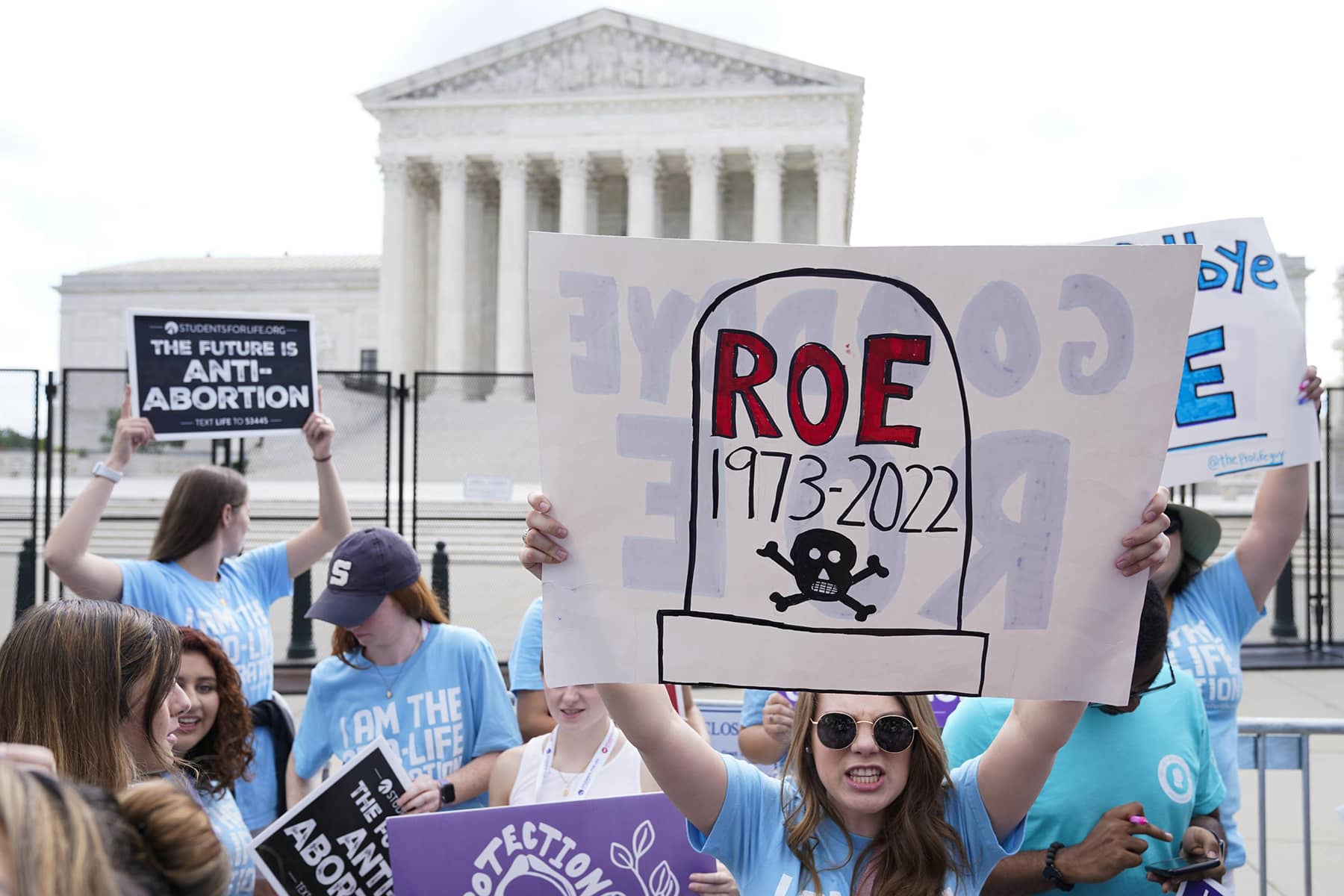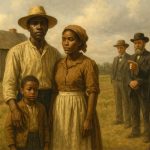
By Linda C. McClain, Professor of Law, Boston University; Nicole Huberfeld, Edward R. Utley Professor of Health Law and Professor of Law, Boston University; and Morgan Marietta, Associate Professor of Political Science, UMass Lowell
After half a century, Americans’ constitutional right to get an abortion has been overturned by the Supreme Court. The ruling in Dobbs v. Jackson Women’s Health Organization, handed down on June 24, 2022, has far-reaching consequences.
The Supreme Court decided by a 6-3 majority to uphold Mississippi’s ban on abortion after 15 weeks of pregnancy. In doing so, the justices overturned two key decisions protecting access to abortion: 1973’s Roe v. Wade and Planned Parenthood v. Casey, decided in 1992. The court’s opinion, written by Justice Samuel Alito, said that the Constitution does not mention abortion. Nor does the Constitution guarantee abortion rights via another right, the right to liberty.
What did the Supreme Court rule?
The opinion rejected Roe’s and Casey’s argument that the constitutional right to liberty included an individual’s right to privacy in choosing to have an abortion, in the same way that it protects other decisions concerning intimate sexual conduct, such as contraception and marriage. According to the opinion, abortion is “fundamentally different” because it destroys fetal life.
The court’s narrow approach to the concept of constitutional liberty is at odds with the broader position it took in the earlier Casey ruling, as well as in a landmark marriage equality case, 2015’s Obergefell v. Hodges. But the majority said that nothing in their opinion should affect the right of same-sex couples to marry.
Alito’s opinion also rejected the legal principle of “stare decisis,” or adhering to precedent. Supporters of the right to abortion argue that the Roe and Casey rulings should have been left in place as, in the words of the Casey ruling, reproductive rights allow women to “participate equally in the economic and social life of the Nation.”
The ruling does not mean that abortion is banned throughout the U.S. Rather, arguments about the legality of abortion will now play out in state legislatures, where, Alito noted, women “are not without electoral or political power.”
States will be allowed to regulate or prohibit abortion subject only to what is known as “rational basis” review – this is a weaker standard than Casey’s “undue burden” test. Under Casey’s undue burden test, states were prevented from enacting restrictions that placed substantial obstacles in the path of those seeking abortion. Now, abortion bans will be presumed to be legal as long as there is a “rational basis” for the legislature to believe the law serves legitimate state interests.
In a strenuous dissent, Justices Stephen Breyer, Elena Kagan and Sonia Sotomayor faulted the court’s narrow approach to liberty and challenged its disregard both for stare decisis and for the impact of overruling Roe and Casey on the lives of women in the United States. The dissenters said the impact of the decision would be “the curtailment of women’s rights, and of their status as free and equal citizens.” They also expressed deep concern over the ruling’s effect on poor women’s ability to access abortion services in the U.S.
What does this ruling mean?
This is a revolutionary ruling. Not just for abortion, but for the ongoing debates over the nature of rights under the Constitution. The ruling signals a massive change in how we read the Constitution, from a living reading to an original reading. The court has firmly rejected the theory of the living Constitution, which argues that the meaning of the document’s language changes as the beliefs and values of Americans change.
The living view, which prevailed at the Supreme Court during the second half of the 20th century, means that additional rights can emerge over time, including abortion, privacy and same-sex marriage. The living Constitution is updated through the judgment of the justices of the Supreme Court, who determine when public values have changed, and hence new rights have emerged.
Originalism, which is the approach taken by the justices who overruled Roe, rejects the living Constitution. In the originalist view, the Constitution is static until officially altered by amendment. It does not evolve on its own without public approval. The role of the justices is to determine the original public meaning of the text, but to leave other decisions to democratic representation through elections.
Regarding abortion, the conclusion of Dobbs is clear: “The Constitution does not prohibit the citizens of each State from regulating or prohibiting abortion. Roe and Casey arrogated that authority. We now overrule those decisions and return that authority to the people and their elected representatives.”
“Arrogated” is an unusual word; it means to take without justification, implying that it is done in an arrogant way. That is the core argument of Dobbs: Roe was the court being arrogant, taking power the justices didn’t have, which rightly belongs with “the people,” a Revolutionary-era term in a revolutionary ruling.
Where does this decision fit into the history of reproductive rights in the U.S.?
This is a huge moment. The court’s ruling has done what reproductive rights advocates feared for decades: It has taken away the constitutional right to privacy that protected access to abortion. This decision was decades in the making. Thirty years ago when Casey was being argued, many legal experts thought the court was poised to overrule Roe. Then, the court had eight justices appointed by Republican presidents, several of whom indicated readiness to overrule in dissenting opinions.
Instead, Republican appointees Anthony Kennedy, Sandra Day O’Connor and David Souter upheld Roe. They revised its framework to allow more state regulation throughout pregnancy and weakened the test for evaluating those laws. Under Roe’s “strict scrutiny” test, any restriction on the right to privacy to access an abortion had to be “narrowly tailored” to further a “compelling” state interest. But Casey’s “undue burden” test gave states wider latitude to regulate abortion.
Even before the Casey decision, abortion opponents in Congress had restricted access for poor women and members of the military greatly by limiting the use of federal funds to pay for abortion services.
In recent years, states have adopted numerous restrictions on abortion that would not have survived Roe’s tougher “strict scrutiny” test. Even so, many state restrictions have been struck down in federal courts under the undue burden test, including bans on abortions prior to fetal viability and so-called “TRAP” – targeted regulation of abortion provider – laws that made it harder to keep clinics open.
President Donald Trump’s pledge to appoint “pro-life” justices to federal courts – and his appointment of three conservative Supreme Court justices – finally made possible the goal of opponents of legal abortion: overruling Roe and Casey.
Why is there now no right to abortion, when Roe recognized it?
The new originalism of the court’s majority argues that if a right is present in the text and original public meaning of the Constitution, including the Bill of Rights and any other amendments, then the decision is beyond the reach of majority rule. But rights must be clear and established in order to wield that sort of influence.
The explicit rights clearly described and enumerated in the Bill of Rights — freedom of religion, freedom of speech, freedom to bear arms and others — are rising in influence, specifically because they have been approved and ratified by the people.
But the other evolved or implicit rights that have been recognized by the court over time – abortion and gay marriage, among others – are simply not constitutional rights in the view of the new majority. Enumerated rights – the ones specifically spelled out in the Bill of Rights – will be accorded stronger protections, while the recently recognized rights of the living Constitution will not be protected.
Under Roe, the majority saw abortion as within the category of rights. Hence it received constitutional protection. But under the new abortion decision, it should be governed by majority rule, the kind of question that is to be determined by the citizens of each state through their legislatures.
Even the originalist justices, however, recognize that there are some unenumerated rights which, though not spelled out in the Constitution, should be given constitutional protection. The Ninth Amendment explicitly argues for their existence: “The enumeration in the Constitution, of certain rights, shall not be construed to deny or disparage others retained by the people.”
So how do we know what those rights are? The court has settled on something known as the Glucksberg standard from 1997: Americans hold those additional rights that are “deeply rooted in the Nation’s history and tradition.”
In other words, if during the early phase of American history – roughly the 100-year period between the founding and the 14th Amendment, the 1770s to the 1870s – Americans publicly asserted the existence of a right, then it exists. But if they did not, then it does not exist. Under the Glucksberg standard, there has to be clear historical evidence from public debates, political speeches or judicial rulings that the right was asserted and recognized.
In Justice Samuel Alito’s majority opinion in Dobbs, he provides a review of the history of abortion: “The inescapable conclusion is that a right to abortion is not deeply rooted in the Nation’s history and traditions. On the contrary, an unbroken tradition of prohibiting abortion on pain of criminal punishment persisted from the earliest days of the common law until 1973,” Alito writes.
In the future, the court may rely on its own reading of history to determine which rights exist under the Constitution. But if the record is uncertain, the justices are far more likely to allow states to decide for themselves, rather than “usurp the power to address a question of profound moral and social importance that the Constitution unequivocally leaves to the people,” wrote Alito.
Is a fetus now a person?
Each state will decide. The abortion debate has two core questions: Is there a right to abortion? And is a fetus a person? Even if a right exists, this does not justify the killing of a person – who is another holder of rights. In Roe, the court decided for the nation what the boundaries of fetal personhood were in the early stages of pregnancy: A fetus could not be considered a person before viability at approximately six months, but states could decide during the last trimester. In Dobbs, the court changes course and allows each individual state to make its own determination.
Whether the court should decide disputed realities is a deeply divisive question. There was a fascinating case called Kahler v. Kansas decided in 2020, which addressed the specific question of who gets to decide disputed social facts. In that case it was the boundaries of insanity: Could Kansas define mental illness and hence the insanity defense differently than other states? Does there have to be one definition throughout the nation about such matters as what counts as legally insane, or can we have variation?
In a decision written by Justice Elena Kagan, the court ruled that when realities are uncertain, individual state legislatures could decide for themselves. The same now applies to the personhood of a fetus. The power of individual states to decide social realities within their borders is the future of many constitutional disputes.
As Alito writes: “In some states, voters may believe that the abortion right should be even more extensive that the right that Roe and Casey recognized. Voters in other States may wish to impose tight restrictions based on their belief that abortion destroys an ‘unborn human being.’”
What effect will the ruling have on other issues?
In overturning Roe, the majority’s opinion offers a new and weaker standard for overturning the past rulings of the court. Simply put, precedents will be easier to overturn in the future.
For 30 years, the Casey ruling, which upheld the core of Roe in 1992, has been considered the “precedent on precedent.” It established four considerations for the legitimate discarding of a previous decision: the ruling misunderstood the Constitution; it proved to be unworkable in practice; new facts have emerged; and it accounts for what are known as “reliance interests,” where citizens had been guided by a ruling in making decisions about their lives.
Dobbs reverses Roe by rewriting the law of precedent. This will open up many other cases for reversal. The most significant change is what Alito calls “the quality of reasoning.” Rulings that “looked like legislation,” offered faulty history or created standards unjustified by the Constitution can be overruled under the Dobbs standard.
The ruling includes a footnote describing all of the recent cases in which the court has overturned precedents. It may be the longest footnote in contemporary Supreme Court history, coming in at over a page and a half. The conclusion is that the meaning of the Constitution is more important than the history of the court, so precedent “does not compel unending adherence to Roe’s abuse of judicial authority,” Alito wrote.
Contrary to much speculation and worry, the Dobbs ruling and the new majority will not overturn protections of interracial marriage, especially the landmark ruling in Loving v. Virginia. That ruling hinges on the equal protection clause of the 14th Amendment, which is also enshrined in the text and is clearly protected under an original reading.
But other nonenumerated, evolved or created rights that are not textually protected are now up for question. This includes the right of same-sex marriage recognized by Obergefell v. Hodges in 2015.
Questions of rights not explicitly protected by the Constitution – and therefore now in the hands of state legislatures – will rely much more heavily in the future on local democracy. Social movements, campaigns and elections, all at the state level, will become the main battleground of American rights.
What happens next?
Even before Dobbs, the ability to access abortion was limited by a patchwork of laws across the United States. Republican states have more restrictive laws than Democratic ones, with people living in the Midwest and South subject to the strongest limits.
Thirteen states have so-called “trigger laws,” which greatly restrict access to abortion. These will soon go into effect now that the Supreme Court has overturned Roe and Casey, requiring only state attorney general certification or other action by a state official.
Nine states have pre-Roe laws never taken off the books that significantly restrict or ban access to abortion. Altogether, nearly half of states will restrict access to abortion through a variety of measures like banning abortion from six weeks of pregnancy – before many women know they are pregnant – and limiting the reasons abortions may be obtained, such as forbidding abortion in the case of fetal anomalies.
Meanwhile, 16 states and the District of Columbia protect access to abortion in a variety of ways, such as state statutes, constitutional amendments or state Supreme Court decisions. None of the states that limit abortion access currently criminalize the pregnant person’s action. Rather, they threaten health care providers with civil or criminal actions, including loss of their license to practice medicine.
Some states are creating “safe havens” where people can travel to access an abortion legally. People have already been traveling to states like Massachusetts from highly restrictive states. The court’s decision may drive federal action, too.
The House of Representatives passed the Women’s Health Protection Act, which protects health care providers and pregnant people seeking abortion, but Senate Republicans have blocked the bill from coming up for a vote. Congress could also reconsider providing limited Medicaid payment for abortion, but such federal legislation also seems unlikely to succeed.
President Joe Biden could use executive power to instruct federal agencies to review existing regulations to ensure that access to abortion continues to occur in as many places as possible. Congressional Republicans could test the water on nationwide abortion bans. While such efforts are likely to fail, these efforts could cause confusion for people who are already vulnerable.
What does this mean for people in America seeking an abortion?
Unintended pregnancies and abortions are more common among poor women and women of color, both in the U.S. and around the world.
Research shows that people have abortions whether lawful or not, but in nations where access to abortion is limited or outlawed, women are more likely to suffer negative health outcomes, such as infection, excessive bleeding and uterine perforation. Those who must carry a pregnancy to full term are more likely to suffer pregnancy-related deaths.
The state-by-state access to abortion resulting from this decision means many people will have to travel farther to obtain an abortion. And distance will mean fewer people will get abortions, especially lower-income women – a fact the Supreme Court itself recognized in 2016.
But since 2020, medication abortion – a two-pill regimen of mifepristone and misoprostol – has been the most common method of ending pregnancy in the U.S. The coronavirus pandemic accelerated this shift, as it drove the Food and Drug Administration to make medication abortions more available by allowing doctors to prescribe the pills through telemedicine and permitting medication to be mailed without in-person consultation.
Many states that restrict access to abortion also are trying to prevent medication abortion. But stopping telehealth providers from mailing pills will be a challenge. Further, because the FDA approved this regimen, states will be contradicting federal law, setting up conflict that may lead to more litigation.
The Supreme Court’s rolling back a right that has been recognized for 50 years puts the U.S. in the minority of nations, most of which are moving toward liberalization. Nevertheless, even though abortion is seen by many as essential health care, the cultural fight will surely continue.
Jаcquеlyn Mаrtіn
Originally published on The Conversation as Roe overturned: What you need to know about the Supreme Court abortion decision and ‘A revolutionary ruling – and not just for abortion’: A Supreme Court scholar explains the impact of Dobbs
Support evidence-based journalism with a tax-deductible donation today, make a contribution to The Conversation.














